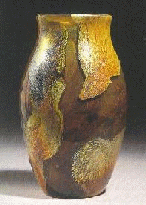
Written
by Rosemary Trietsch
We cannot say with certainty
when and where glass was invented, but history supports man’s fascination with
it through the ages. Archeologists have found glass articles in Egyptian tombs
dating back to the 4th millenium B.C: urns for the kings to use in
the next world, as well as glass beads adorning the royal robes.
Bowls with gold and enamel decoration dating to the 2nd
Century AD have been unearthed in the Roman Catacombs. Even in America, the
English settled Jamestown in 1607 and opened the Jamestown Glassworks by 1609.
Through the ages, glass has managed to play an important role in both the
practical and artistic side of civilization; assisting in the daily routine
while raising the commonplace to a higher level. (After all, solid windowpanes
serve the same function as stain glass panels, or do they?)
As
much as we like to think we’ve “invented the wheel,” today’s glass
collectors are just following that trend. Like those who’ve gone before us, we
marvel at the artistry that turns something with no intrinsic value into a work
of art. Think about it: glass, at its most elemental level, is nothing more than
sand, potash and a sprinkling of metal oxides that are melted down and then
cooled. Yet somehow, the glass blower imposes his structure on this
molten rock to create a new substance that captures movement and color and
light; that is fragile yet permanent at the same time. He takes a common item
like a plate or a vase and turns it into something that delights our senses and
touches our hearts each time we use it.
Sure, some people collect with an eye toward investment value only. But
more glass collectors buy items because they admire beautiful things; and
perhaps the largest group collects because of the memories awakened by a single
piece. Somehow, the experiences of every day life become tangible when we find a
bowl just like the one Grandma always used to serve custard, or a vase like the
one Mom filled with lilacs each spring. We value the things that the people we
love have cherished. They keep us connected to our past, ground us in our
present, and become memories we create for future generations.
In
many ways, then, today’s glass collectors are preserving a part of history. We
perpetuate our family histories by collecting and caring for those items with
special significance to us. At the same time, we are gathering together and
carefully recording a tangible history of the glass industry. Like archeologists
digging through sediment, we hunt for the illusive piece that will, with luck,
complete our set and help solve the
mystery surrounding the provenance of an unidentified item. Ultimately, the
reason we collect is our love of glass, and our desire to surround ourselves
with things we know to be useful, and think to be beautiful.
GLASS CATEGORIES
There are as many different ways to collect glass, as there are glass collectors. Some people collect by color, others by pattern, still others by company or style period.
Some folks have very refined collections that only include a specific article –like covered candy jars or shot glasses - and lots of people collect single cup & saucer sets. Then of course, there are those collectors who buy everything and anything they see because they love it all and can’t decide…. Remember: there are no hard and fast rules in assembling your collection. Buy what you like and enjoy your glass.
Following, is a list and brief description of some of the more common categories of glass to help you on your collecting journey. It is by no means complete - we’re only whetting your appetite - but is meant to highlight some of the more popular types of glass and styles of glass collecting. As you read through it, you may discover that your budding collection has already fallen into a specific genre, and we’d like to take this opportunity to recommend that your next glass purchase should be a book. There are wonderful books available on each of these subjects: most include a history of the glass’ production, lists of pieces available in each pattern, a general price guide, and rare items to watch for. For many collectors, the thrill of identifying something that they just purchased rivals that of the hunt.
Art Glass - is hand made glass that was produced from the late 1800’s through the 1950’s. This type of glass was hand worked, so no two pieces will be exactly the same. Tiffany, Steuben, Loetz, D’Argental, and Durand are just a few of the companies who produced art glass.

Tiffany Vase
Contemporary Glass, 1970’s – present is a modern day continuation of the art glass category. Contemporary glass refers to hand made glass produced by studio artists in the last part of the 20th century. Chihuly, Lotton, Lundberg, and lesser-known individual artisans would fall into this category. (If you’re a glass artisan, you can consider yourself part of this crowd.)
Carnival Glass - is pressed glass that has been treated with metallic salts and then re-fired to give the glass an iridescent finish. It was used as prizes at carnivals and country fairs (throw the penny in the bowl and win it) and that’s where the name comes from. Vintage carnival glass was produced from 1905 to 1920 and was sometimes called ‘poor man’s Tiffany’ as it had beautiful iridescence reminiscent of Tiffany art glass but was affordable to everyone. In the 1960’s, some carnival was reproduced in new colors with marks to differentiate old from new: this Contemporary carnival is also collectible today.
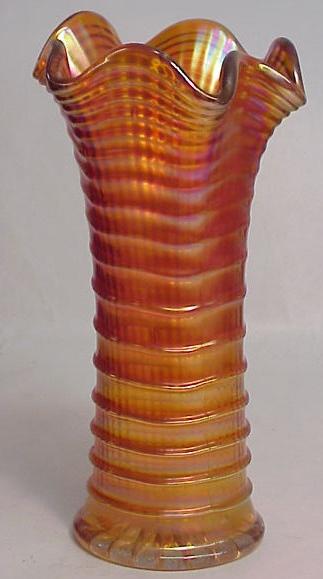
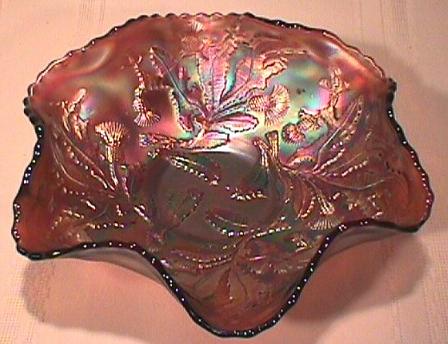
Carnival Glass
Depression Glass - is machine produced glass made in America from the mid 1920’s through the 1930’s. It was inexpensive and came in a variety of colors: pink, red, green, amber, yellow, blue, cobalt, white and crystal. Depression glass was used as premiums with purchases food products and soaps, as well as given out in movie theatres and gas stations.
Collectible 40’s 50’s 60’s Glass - is a continuation of Depression glass. This category includes patterns made by the depression era companies after 1940 and through the 1960’s. (By that time, most of the original glass producers from the depression years were either out of business or absorbed into other companies.) Again, it tends to be machine produced and was inexpensive, every day glassware.
Elegant Glass - is the name for better quality hand made glassware that was produced during the depression years and through the 1950’s. Unlike regular Depression glass, which was completely machine produced, Elegant glass was machine molded then finished by hand – etched, polished, reshaped and ground. Elegant glass was sold in better gift stores and department stores, and was made for longer periods of time. Folks could add to their ‘wedding stemware’ or complete Grandma’s set that they had inherited.
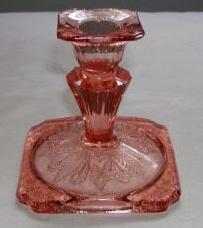
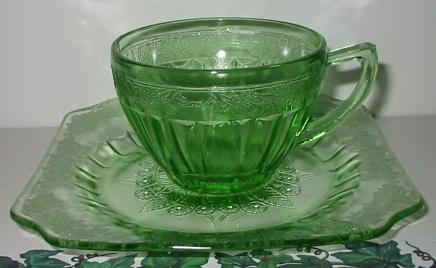
Depression Glass (Adam pattern)
Kitchen Glass - refers to glassware made during the Depression years that would have been used primarily in the kitchen (or bathroom: towel bars and cabinet knobs, for example) Mixing bowls, canisters and measuring cups are just a few examples.
FireKing - was made by the Anchor Hocking Company beginning about 1940 and through 1976. FireKing was glassware that was advertised as going from freezer to oven to table to refrigerator without breaking. It included all sorts of kitchenware – from mixing bowls and roasting pans to dinnerware lines. Hocking made FireKing to compete with Corning’s Pyrex Glass, (whose name literally means ‘Fire King’ in Latin) and which was also a line of glass kitchenware. Vintage Pyrex is also quite collectible today.
Crystal - refers to better quality stemware and decorative items made by companies like Lenox, Baccarat, and Gorham during the 20th century. (Think “Bridal Registry” and you’re in the right place.) Crystal tends to have lead in the glass, giving it that wonderful ringing sound when tapped gently.
Cut Glass/EAPG - is glass produced from the early 1800’s through 1915. The glass is heavy and the patterns are cut into it by hand using various types of cutting wheels on a lathe. Early American Pattern Glass was produced from 1840 through 1915 as well. Like Cut glass, EAPG is heavy, but the pattern is molded into the glass rather than cut.
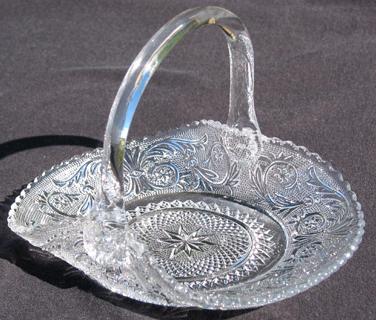
EAPG Basket
Glass by Companies – Many collectors focus on the glassware produced by a specific company. Some of the best known companies are Cambridge, Dugan, Durand, Fenton, Fostoria, Fry, Heisey, Higgins, Higbee, Imperial, Loetz, Morgantown, Moser, Murano, New Martinsville, Steuben, Tiffany, Tiffin, and Westmoreland.
Glass by Color – One of the easiest collecting formulas in the glass world is to collect by color. You don’t need to know lots about glass, just look for the right hue. Some of the more commonly collected colors are black, cobalt, custard (opaque cream), Forest Green, jadeite (opaque green), milk (opaque white), pink, ruby, slag, and vaseline (yellow-green), but feel free to choose what’s pleasing to your eye.
Glass by Country – Another popular collecting trend is to focus on the glass from a specific country or geographic region. American, Bohemian, Czechoslovakian, European Decorative, and Venetian glass are just a few examples.
Glass Items – This group speaks for itself. Glass animals, apothecary, Avon bottles, beads, bottles, buttons, candleholders, candy containers, cartoon/promotional glasses, cruets, fruit jars, ink wells, insulators (those glass caps that were used to hold telegraph wires to the tops of poles), jewelry, lamps, marbles, ornaments, paperweights, perfume bottles, shoes, shot glasses, and toothpick holders are only a few of the thousands of glass items people look for.